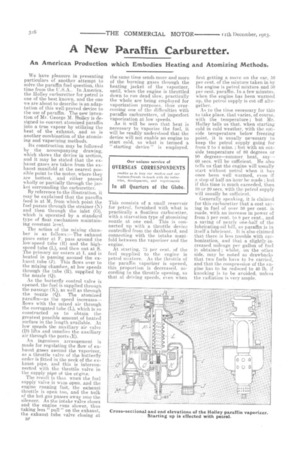A New Paraffin Carburetter.
Page 4

If you've noticed an error in this article please click here to report it so we can fix it.
An American Production which Embodies Heating and Atomizing Methods.
We have pleasure in presenting particulars of another attempt to solve the paraffin fuel question, this time from the U.S.A.. In America, the Holley carburetter for petrol is one of the best known, and the one we are about to describe is an adaptation of this well-proved device to the use of paraffin. The new invention of Mr. George M. Holley is designed to convert atomized paraffin into a true vapour by utilizing the heat of the exhaust, and so is another 'combination of the atomizing and vaporizing methods.
Its construction may be followed by the accompanying drawing, which shows the device in section, and it may be stated that the exhaust gases are taken from the exhaust manifold at the nearest possible point to the motor, where they are hottest, and either passed wholly or partially through the jacket surrounding the carburetter. By reference to the illustration, it may be explained that the paraffin feed is at M, from which point the fuel passes through the strainer (N) and then through the inlet (0), which is operated by a standard type of float, mechanism maintaining constant level.
The action of the mixing chamber is as follows :—The exhaust gases enter at F, pass around the low-speed tube (R) and the highspeed tube (L), and then out at S. The primary air enters at I, and is heated in passing around the exhaust tube (J). This flows over to the mixing chamber, at low speeds through the tube (R.), supplied by the nozzle (Q).
As the butterfly control valve is opened. the fuel is supplied through the passage (K), as well as through the nozzle (Q). The atomized paraffin—as the speed increases— flows with the mixed air through the corrugated tube (L), which is so constructed as to obtain the greatest possible amount of heated surface in the length available. At low speeds the auxiliary air valve (D) lifts and supplies the auxiliary air through the ports ‘E).
An ingenious arrangement is made for regulating the flow of exhaust gases around the vaporizer, as a throttle valve of the butterfly order is fitted in the neck of the exhaust pipe. and this is interconnected with the throttle valve in the supply pipe of the ergine. The re-stilt is that when the fuel supply valve is witte open. and the engine running fast, the exhaust throttle is open too, and the bulk of the hot gas passes away into the silencer. As the intake valve closes and the engine runs slower, thus taking less " pull " on the exhaust, the exhaust tube valve closing at BP the same time sends more and more of the burning gases through the heating jacket of the vaporizer, until, when the engine is throttled down to run dead slow, practically the whole are being employed for vaporization purposes, thus overcoming one of the difficulties with paraffin carburetters, of imperfect vaporization at low speeds.
As it will be seen that heat. is necessary to vaporize the fuel, it will be readily understood that the device will not enable an engine to start cold, so what is termed a "starting device" is employed.
This consists of a small reservoir for petrol, furnished with what is practically a floatless carburetter, with a starvation type of atomizing nozzle at one end. This is connected up with a throttle devico -controlled from the dashboard, and connecting with the intake manifold between the vaporizer and the engine.
At starting, 75 per cent. of the fuel supplied to the engine is petrol mixture. As the throttle of the paraffin vaporizer is opened, this proportion is decreased, according to the throttle opening, so that at driving speeds, even when
first getting a. move on the car, 50 per cent, of the mixture taken in by the engine is petrol mixture and 50 per cent. paraffin. In a few minutes. when the engine has been warmed up, the petrol supply is cut off altogether.
As to the time necessary for this to take place, that varies, of course, with the temperature ; but Mr. Holley tells us that, when starting cold in cold weather, with the outside temperature below freezing point, it is usually neeessary to keep the petrol supply going for from 2 to 4 mins. ; but with an outside temperature of 80 degrees or 90 degrees—summer heat, say60 secs. will be sufficient. He also tells us that the engine will usually start without petrol when it has once been well warmed, even if a stop of half-an-hour be made ; but if this time is much exceeded, then JO or 20 secs. with the petrol supply will usually be sufficient.
Generally speaking, it is claimed for this carburetter that a cost saving in fuel of over 50 per cent. is made, with an increase in power of from 5 per cent. to 8 per cent., and a saving of nearly one-half of the lubricating-oil bill, as paraffin is in itself a lubricant. It is also claimed that there is less trouble with carbonization, and that a slightly-increased mileage per gallon of fuel is obtained ; whilst, on the othet side, may be noted as drawbacks that two fuels have to he carried, and that the compressiop of the engine has to be reduced to 40 lb. if knocking is to be avoided, unless the radiation is very ample.


























